 Image search results - "drummer" Image search results - "drummer" |

A huge number of taiko drummers perform near the finish line. This taiko group is called Kodaijin. 鼓代神 Web site at www.geocities.jp/kodaijin_kdj/
|
|
|

Taiko drummers near the finish line.
|
|

Taiko drummers near the finish line.
|
|
|
|

Check out the little girl too. She was good.
|
|
|
|
|
|

Ganbare!
|
|

By 3:30 pm, the stream of runners became walkers.
|
|
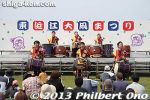
Taiko drummers.
|
|
|
|
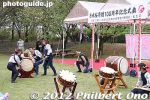
Local taiko drummers also performed.
|
|
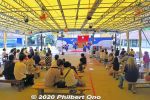
Super Eisa Show is performed three times a day for 30 min. スーパーエイサーショー
|
|
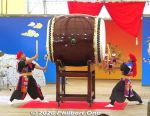
Large taiko drum.
|
|
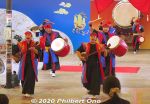
Okinawan Eisa drummers.
|
|
|
|
|
|
|
|

Okinawan shishi-mai lion dance.
|
|

Okinawan shishi-mai lion dance.
|
|
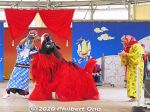
Okinawan shishi-mai lion drinking awamori.
|
|
|
|
|
|
|
|
|
|
|
|
|
|
|

Great show! Saw it twice.
|
|

Held only once every 5 years, the Ibuki-yama Taiko Drum Dance was held on Oct. 3, 2010 in Ueno, a small neighborhood at the foot of Mt. Ibuki.
|
|

The festival started at noon near the Ueno Kaikan Hall (brown building on right). MAP
|
|
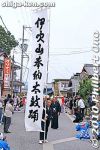
The taiko drum procession is headed by this large banner saying, "Ibuki-yama Hono Taiko Odori" which means Ibuki-yama Taiko Drum Offertory Dance.
|
|
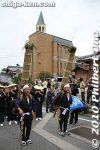
The procession consists of various people including these two torch bearers.
|
|
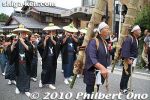
The torch bearers are followed by male flute players.
|
|
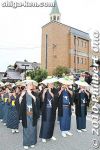
Ibuki-yama Taiko Drum Procession in front of Ueno Kaikan Hall.
|
|
|
|
|
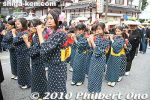
The male flue players are followed by female flute players from a local junior high school.
|
|
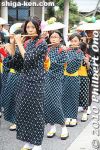
They spent most of the summer practicing for this festival. They are entirely voluntary.
|
|
|
|
|
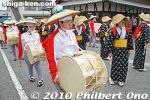
Women dancers and taiko drum players.
|
|
|
|
|
|
|
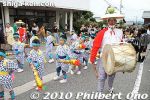
At the end of the procession are these little kids waving a wand attached to a gourd.
|
|

These kids are called fukube-furi.
|
|
|
|
|
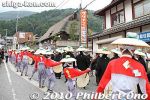
They head for Sannomiya Shrine only about 120 meters away.
|
|
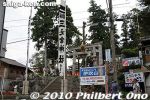
Sannomiya Shrine at the foot of Mt. Ibuki.
|
|

Steps going up to Sannomiya Shrine.
|
|
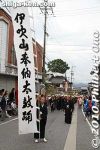
The taiko drum procession proceeded very slowly to the shrine.
|
|
|
|
|
|
|
|
|
|
|
|

Finally, they are in sight of Sannomiya Shrine.
|
|
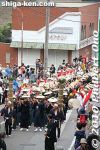
It took them about 90 min. to reach the shrine.
|
|
|
|
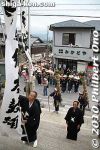
They finally reached the shrine steps.
|
|
|
|

The procession is met by the shrine priest.
|
|
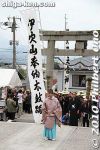
Greeted and led by the shrine priest, the taiko drum procession starts to enter the shrine grounds.
|
|
|
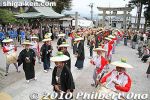
The various groups in the procession enter the shrine grounds after going up the steps and pass through the torii gate.
|
|
|
|
|
|
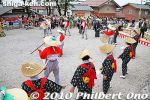
They started to form a circle and danced.
|
|
|
|
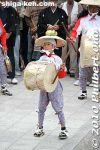
The taiko drummers include a good number of grade school boys who practiced hard during the summer for this festival.
|
|
|
|
|
|
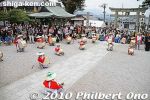
After a while, they sat down and rested while a few speeches were given.
|
|
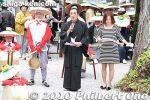
"Long ago, villagers in Ueno at the foot of Mt. Ibuki prayed for rain by doing the thunder dance by beating drums and bells, lighting torches, etc. After the rainfall and a good harvest in autumn, they danced to give thanks. This is what we are danci
|
|

The mayor of Maibara, holding a microphone, says a few words.
|
|
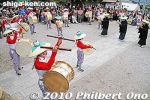
The dance continues.
|
|
|
|
|
|
|
|
|
|
|
|
|
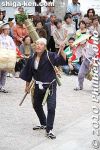
Even the torch bearers danced along.
|
|
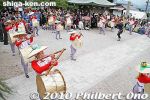
Ibukiyama Taiko Odori Dance, Maibara, Shiga.
|
|
|
|
|
|
|
|
|
|
|
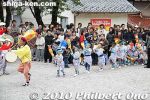
Now the fukube-furi kids came out and paraded around in a circle.
|
|
|
|
|
|
|
|
|
|
|
|
|
|
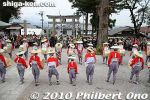
After dancing in a circle, they danced in different formations.
|
|
|
|
|
|

They also performed while sitting on straw mats.
|
|
|
|
|
|
|
|
|
|
|
|
|
|
|
|
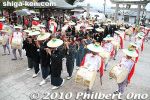
For the finale, they all approached the shrine hall and performed.
|
|
|
|
|
|
|
|
|
|
|
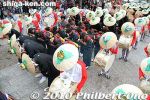
After they finished, they all bowed.
|
|
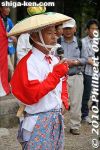
Words of thanks from a group leader.
|
|
|
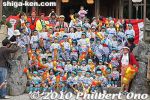
In the end, they had group photo sessions for each group. These are the fukue-furi kids.
|
|
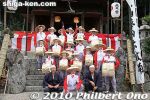
Boy taiko drummers.
|
|
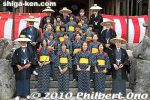
Junior high school flute players.
|
|
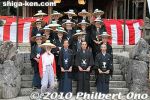
Male flute players and dancers.
|
|
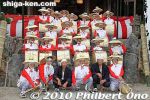
Adult taiko drummers.
|
|
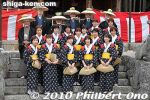
Women background singers.
|
|
|

Taiko drummers
|
|
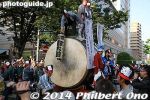
On May 4 from 5 pm to 6 pm, large taiko drums (太鼓の響宴) were beaten on the street near the shrine.
|
|
|
|
|
|
|

Another taiko arrives.
|
|
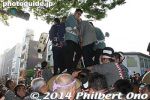
Men standing precariously on one of the smaller taiko drums. They hold on to a rope tied to the drum. The smallest taiko is 1.29 meter wide. Up to 11 people stand on it.
|
|
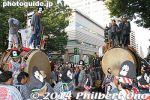
The largest taiko is made of bubinga wood. They even made another taiko from the wood carved out of this trunk.
|
|
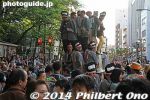
In the old days, they used to ram the taiko drums at each other. Since a bigger taiko was more advantageous, four neighborhoods sought to make the largest drum.
|
|
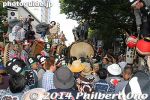
That's how the taiko got bigger and bigger.
|
|
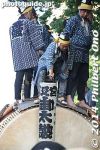
The taiko drums are beaten to purify the path for the mikoshi portable shrine.
|
|
|
|
|
|
|
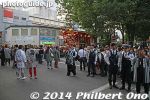
At around 6 pm, the ornate floats started to appear.
|
|
|
|
|
|

Boy drummers show their stuff too.
|
|
|
|

Tsuzumi shoulder drum
|
|

Kasei-ren
|
|

Gojinjo-Daiko is powerful, crazied drumming performance by several men donning demon masks and wigs. They are based in a small village called Nabune in Wajima where Gojinjo-daiko originated.Legend has it that their drumming and fierce-looking masks drove off the invading forces of Uesugi Kenshin, ruler of Echigō Province (Niigata Pref.) during the Warring States Period in the 16th century.
写真提供:©石川県観光連盟
|
|
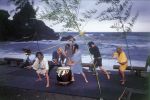
The taiko drummers wear fearsome masks while drumming. Gojinjo daiko commemorate the day when villagers in Nabunemachi in Wajima, Ishikawa Prefecture used crude and frightening masks made of tree bark and seaweed dangling from their heads.写真提供:©石川県観光連盟
|
|
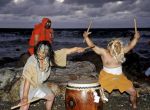
They beat taiko drums when they invaded Lord Uesugi Kenshin's base camp. They used sickles and hoes to chase away the army who was enroute to capture Nanao Castle. The villagers lived happily afterward.写真提供:©石川県観光連盟
|
|
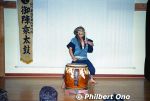
They also perform indoors for free on weekend evenings (or every evening in summer) at Wajima Kiriko Art Museum.
|
|

Gojinjo-Daiko drummers.
|
|
|
|
|
|
|
|
|
|
|
|
|
|
|
|
|
|
|

Old video of gojinjo-daiko drummers performing in Wajima.
|
|
|
|
|
|

The last group in the procession were the taiko drummers led by four bell ringers. 鉦
|
|

There were about 50 taiko drummers. They also practiced every day during summer vacation. The boys drummed, while the girls played the flute.
|
|
|

Taiko drummers in Suijo.
|
|

Finally the taiko drummers. It took about 30 min. for everyone to enter the shrine.
|
|
|
|

The taiko drum dance started as a rainmaking dance in 1671 during a drought. The dance continued until 1947. In 1965, they revived the dance, but held it only once every 5 years due to the cost.
|
|

The next time this taiko dance will be held will be in Oct. 2014. However, a similar taiko drum dance will be held in Oct. 2010 in neighboring Ueno at Sannomiya Shrine at the foot of Mt. Ibuki.
|
|
|

After entering the shrine and drumming for a while, they started to form a circle.
|
|

First they danced in a circle.
|
|
|
|

The taiko drummers are as young as 3rd grade (age 8).
|
|

The young drummers performed very well.
|
|
|

The drummers formed a few different formations. They lined up in front of the shrine and let the fukube-furi children to march through to the shrine.
|
|
|
|
|
|
|

They also had a seated drumming performance.
|
|

They had quickly spread four strips of straw mats on the ground for the drummers.
|
|

The seated drumming was also interesting.
|
|

They face the shrine.
|
|
|
|
|
|
|

Suijo Hachiman Shrine Taiko Odori dance in Maibara, Shiga.
|
|
|
|
|
|
|
|
|
|

Fukube-furi comes through (again).
|
|
|

Again they spread the mats on the ground and did the seated drumming again. They did everything twice.
|
|
|
|
|
|
|
|
|
|
|
|
|
|
|
|
|